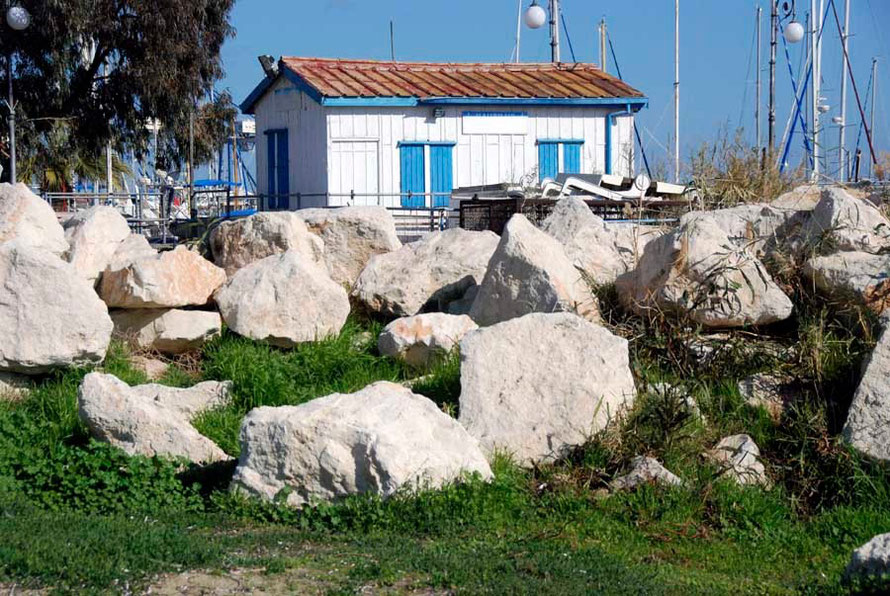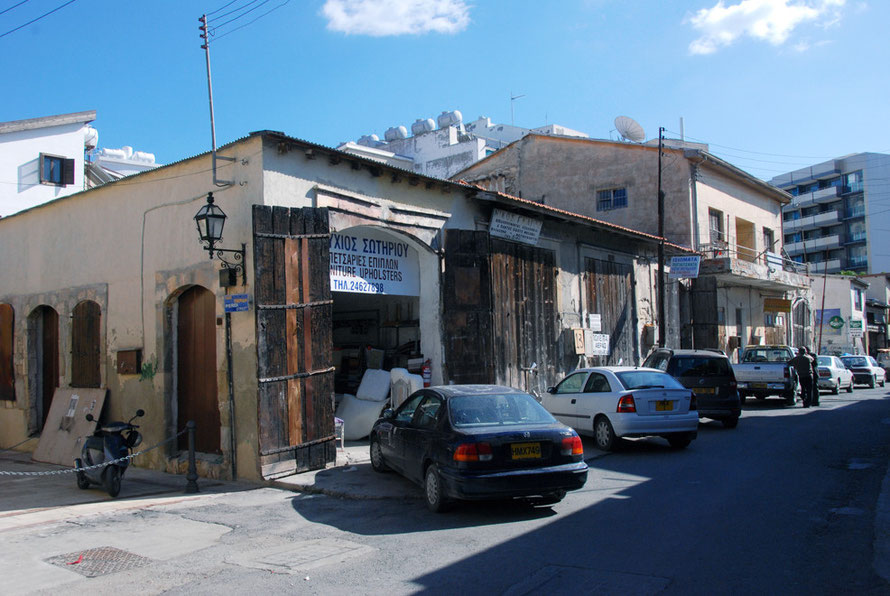Towns V: Larnaca
The bus was knackered and so was the driver. Smoking and yakking on his mobile were the order of the day. He kept it up all the way to Larnaca.
We trundled along happily enough, turning off the motorway to go through an industrial and retail park where the new General Hospital is located. Then back on to the motorway and across the strange landscape (see Interiors). The Troodos mountains were misty in the distance and the wheat fields were brilliant in their flush of early spring growth. Durrell (Bitter Lemons p.129) calls it, 'languid and green as a lover's wish'.
Soon the new suburbs began to appear and they accompanied us down the long slope into Larnaca proper. The driver kept up his good natured telephone call as the traffic thickened and we made our way down to the port. There is much evidence of new building everywhere with brightly painted apartment buildings blocking out the fields and palm trees.
Larnaca (pop. 72,000) – which means the place of sarcophagi – is a modern town built on the site of ancient Kition, founded by the Mycenaeans and was an important centre of Phoenician culture and trade in antiquity. It is now a pretty unappealing collection of bars and increasingly higher-rise apartment complexes catering to the tourist trade.
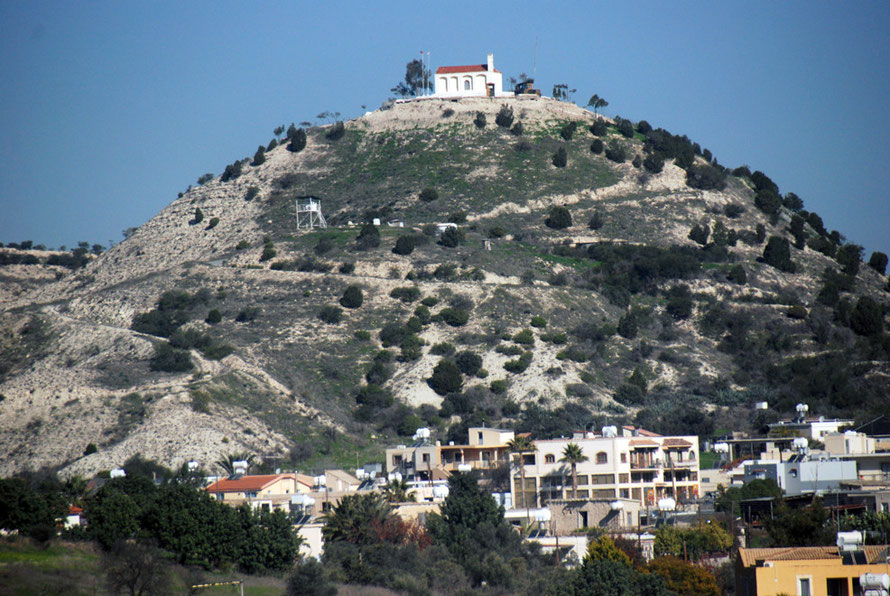
The beach is made of dusty, dark, hard sand and there is an impressive show of palm trees. The beach is called Finikoudes (the Greek Cypriot for 'palm tree') and there are plans to replant it as the original trees imported from the US in 1922 by then Mayor Philios Zanetos which are now aging (Cyprus Mail 2008).
The palm trees are not the elegant Date Palm (phoenix dactylifera) that grace so much of Cyprus but the scraggier California Washingtonia (washingtonia filifera). I wondered if the selection of US trees said something about the association of the Date Palm and the Middle East and was a deliberate effort to wipe out Larnaca's earlier links with Phoenicia.
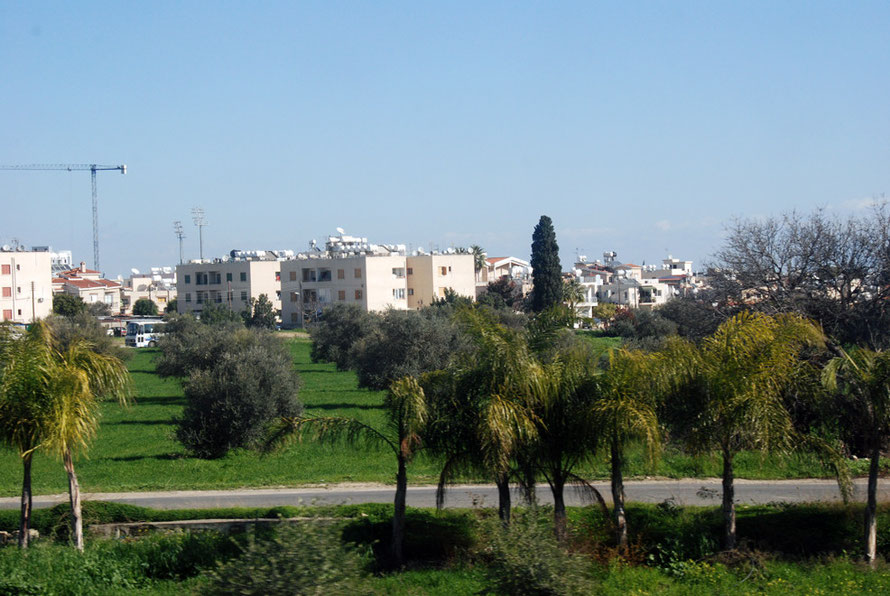
The bright February sun was quite beautiful as it bounced off the waters of the bay. I walked over the unlovely sand and down to the water's edge. There was a pungent smell of iodine rot from the piles of sea grass washed in at the water’s edge. To the left of me was the jumbled stone breakwater for the marina made out of large chunks of bright cream limestone. On top of the breakwater was a picturesque orange tile-roofed hut with bright blue shuttered windows. Behind it a sea of yacht masts.

To the right the beach stretched away up towards the distant fishing harbour, the phalanx of sea-facing apartments like a wall with an under-cliff of bars and coffee houses jutting out from their base. A knot of people played boules on the beach. In the summer it would be covered in ranks of sun beds but for now it was exhilarating in the vibrant sunlight. This was how I had imagined the February sun might feel and after the strangely traumatic gritty streets of Nicosia it felt fantastic. I bought a bottle of cold water to rinse out the previous night's wine and walked along the beach.

Nearby Europa Square boasts a beautifully restored two storey porticoed Customs building with stone-framed terraces of stores painted in a powder blue. Standing in the middle of the square is an attractive, elongated sculpture by Kikis Patsalos of Zeno of Kition 352-255 BC, founder of the Stoic school of philosophy.
According to Robin Turner at Sensible Marks and contrary to popular views, Stoicism was not a gruff and grudging, tight-lipped acceptance of man and woman's lot. In many ways it was more akin to anarchy and apparently Zeno liked nothing better than to sit and eat figs and drink wine.

His passage into the world of philosophy was unusual. For most of his youth he was a merchant, so the story has it, and at the age of thirty, he was shipwrecked while transporting purple dye from Phoenicia to Athens. While kicking his heels in the big city, he frequented a bookshop, where he was drawn to the works of Socrates. And the rest is history, so the story goes.
Zeno proposed an ideal community of rational beings, who would have no need of law, government or codes of morality beyond that provided by Reason itself. However, Stoics had to live in an imperfect society, and thus had to accept social realities; thus while marriage was an imperfect institution, adultery was considered, on balance, to be worse. While the Cynics tended to withdraw from society (like their Chinese counterparts, the early Taoists), the Stoics seem to have advocated "permanent protest": in society but against it, as it were.
I then wandered through the increasingly hot morning towards the Archaeological Museum. I took a number of wrong turns and walked through some quietly beautiful residential streets and back round on the museum.
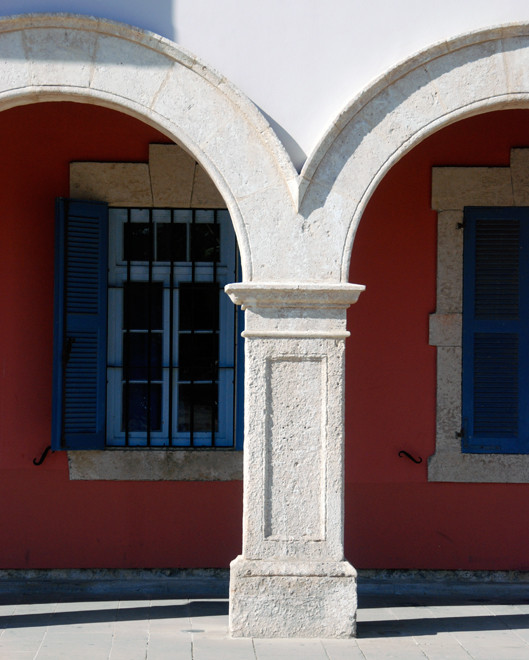


Three attendants were staffing the desk at the museum and I was the sole visitor. The pottery was impressive and I particularly liked an early small terracotta figure of a sitting woman holding her hands under her large breasts. The other sculpture was unremarkable.
Outside and in front of the museum was a beautiful carved pillar capital which looked spectacular in the sun. Round the back of the museum was a covered area - like large bicycle rack - that held a collection of massive unfinished limestone sculptures. They were roughed out of huge chunks of stone and gave a real sense of the transformative effort made by thousands of unknown craftsmen over the millenia of the ancient world using unsophisticated tools of stone, copper, brass and soft early steels.
Behind the sculptures was an ancient olive oil mill discovered when the Larnaka-Nicosia motorway was being dug out. It was an impressive affair. The olives were first crushed by a rolling stone in a grooved circular run. They were then placed in loose woven sacks and put under the head of the press – a huge timber pivoted timber mast. Large rough hewn boulders with holes in them were then lifted up and hung on the end of the massive lever to increase the crushing force on the olives.

Larnaca Archeological Museum
I looked over the chain fence into the one of the areas of the Kition excavation – the Bamboúla Hill. There was, as Eddie Izzard would say, 'a series of low walls'. Further away, and too far away for me, was an area of greater interest that attests to the long settlement of Phoenicians in Cyprus. As the Rough Guide puts it, this is politically sensitive, 'as Greek Cypriots are often less than enthusiastic about remains indicating Asian origins'. p.93. The Phoenicians were from the Levant – Tyre, Sidon, Biblos, and Acre - on the Mediterranean coast not 100 miles east of Cyprus.

I left the museum and headed back into the very small centre of Larnaca. The sun was by now burningly bright yet low in the sky. The traffic for such a small place was getting impressively snarled up. I marched doggedly along looking for the Pierides Museum, eventually finding it in a beautiful veranda-ed town house on one of Larnaca’s busier streets.
From the Pierides Collection Larnaca
I then moved back out into the sun and walked to the St Lazarus church. On my way I went a bit wrong and started down an alley way into the old Turkish quarter. I passed some artisan workshops, with 3 metre high double wooden doors. There was an upholsterer, a furniture-making workshop and a metalworker making zivania stills to produce 'Cyprus whiskey' (eau di vie) as I've heard it called.
Realising I’d missed the church I doubled back past cheap tourist eating places. Agios Lazaros stands in a quiet square, given the traffic that had seemed to be personally plaguing me for the previous half hour. The church is beautiful to behold, the washed and bleached stone, the graceful curves of the domed tiled roofs, the Latinate bell tower that miraculously escaped destruction under the Catholic-hating Ottomans. It rose majestically up into the perfect cerulean and ultramarine sky dotted with a few judiciously wispy clouds.

I climbed the mezzanine seating in the back of the church and the stone work of the arched ceiling was impressive and simple. But otherwise the church, at least to my untutored eye, was crammed with icons, rood screens, chandeliers, pulpits, the works. The crypt was head-removingly low crypt. St Lazarus had briefly reposed there before being whipped off to Constantinople in the 10th century only to be stolen and turn up in Marseille.
In the church square there are shops selling holy things. A little old woman all dressed in black seemed to be warning a middle-aged English couple sitting in shorts and light shirts at a café in the full glare of the mid-day sun to take care – either because they were getting sunburnt or because it would be getting cold later on.
St Lazarus Church



I was weary and hungry after a lot of walking and cultural input, so to speak. The sun was strong and making my head ache. I wandered down to the mosque 100 metres from St Lazarus and into the Ottoman fort on the sea front. The caretaker and his wife had plates of food on chairs out in the sun and it smelt good. One of the dark arched rooms built into the stonework had been used to hang prisoners (until 1948) when the fort served at a British prison – there was a beam and a sunken floor to provide a drop.
There were some German artillery pieces in the courtyard and a useful toilet. The pine door, standing in the full sun, gave off a powerful resinous smell. I was just leaving when the caretaker pointed me to the little museum. There were great views of the sea through the battlements and I could look south along the coast to the fishing harbour.
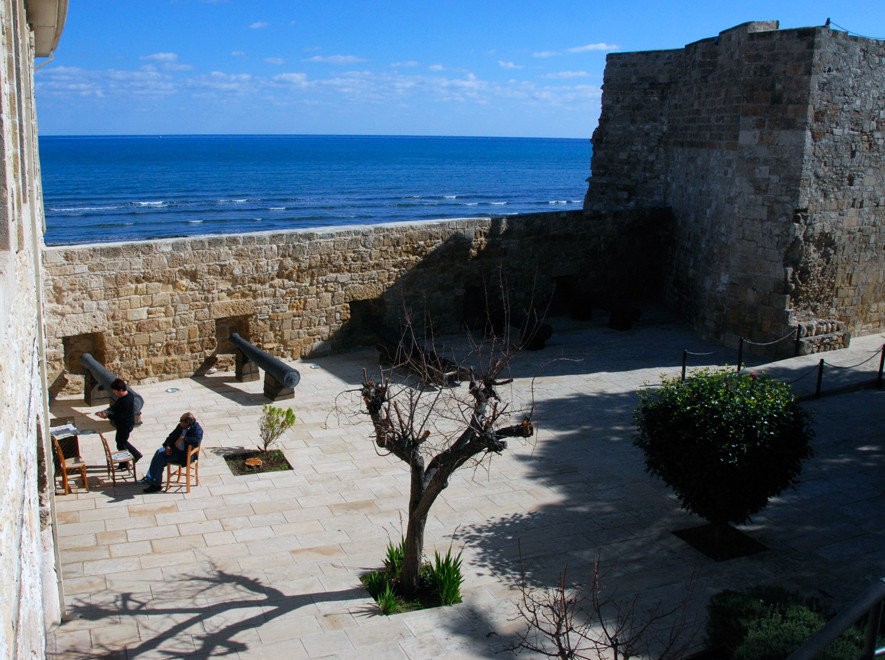

I wandered through the quiet streets of the old Turkish quarter – Skàla – in the baking sun. The houses looked ordered if a little ramshackle and yards ran into a confusion of sheds and corrugated iron. I went by two tiny shops –'Hairdressing – Ladies Only’ and another ‘Barber – traditional rase’.
I saw amongst the clutter two elegant date palm trees, their leaves like an exploding firework; a house with a veranda stuffed with houseplants of every description; a beautiful old double-prowed blue-hulled wooden fishing boat abandoned in a yard of lush weeds; and then a low house, neatly painted in cream and blue, with a ramshackle yard and black graffiti on the new paint work: ‘Fuck Arabs’ and more in Greek. And I could see that there had been previous graffiti that had been painted over. And walking on came to the very modest blue door to the compound with a spray painted ‘26’ and a black arrow pointing to the door. It was absolutely quiet and the blue of the door reflected the absolute blue of the sky.
The old Turkish Cypriot quarter of Skala
This area had once been a thriving Turkish quarter, with its mosque and Turkish street names – like 'Prigkipissis Zehra Street'. But in 1974 Turkish Cypriots had been driven out and gradually replaced by Greek Cypriots from Famagusta and the villages on the Karpas Peninsula. Over one house a big Greek flag flew. I walked into another that was abandoned and empty, windows broken, whitewash peeling, with lightbulbs still in the sockets. A sizeable concrete built factory abandoned. It felt sad and troubled still beneath the surface of the radiant day.
I walked on the fishing harbour to take a few photos of the little inshore boats with their big fixed line spools on the bows. Then I turned back along the row of fish restaurants, many still closed, until I came to the one I had chosen earlier.
Boats at Larnaca fishing port

After an excellent meal (see Fish Restaurant) I made my way back through the old Turkish quarter, the sun lower in the sky, the heat gone, then along the Corniche to the coach stop. A repeat performance of a different coach driver’s indifference to his job and customers. The sun setting over the Troodos, golds and reds, pinks and carmine flaring across the sky.
Back in Nicosia I called into the Moufflon bookshop to be told my book wasn’t there yet. Back up the hill, sun-stunned, full of the Levantine laid-backness of off-season Larnaca, the little kindnesses shown me, and hopefully the kindnesses returned.



